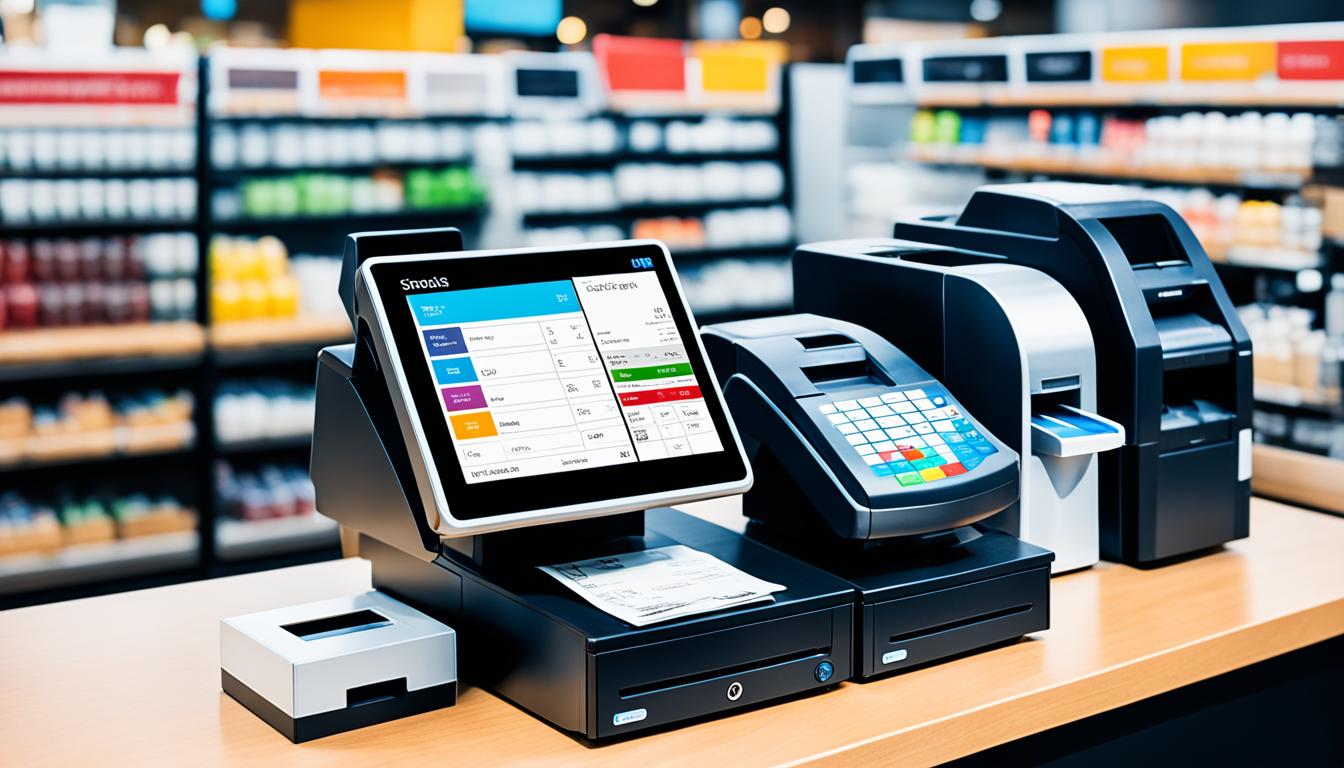Point of Sale (POS) systems are at the heart of modern retail and hospitality businesses, serving as the central hub for transactions and customer interactions. From traditional cash registers to sophisticated digital systems, POS technology has evolved significantly, revolutionizing the way businesses manage sales, inventory, and customer data.
In this insightful guide, we delve into what is point of sale, its key components, and the benefits it offers to businesses of all sizes. Additionally, we’ll provide valuable tips on choosing the right POS system for your business and maximizing its potential to enhance customer service and drive sales. Whether you’re a small business owner or a retail veteran, this guide will equip you with the knowledge to leverage POS technology effectively and efficiently.
What is a Point Of Sale System and How Does it Work?
A POS system, short for Point of Sale system, is a combination of software and hardware used by businesses to facilitate customer transactions and manage sales-related tasks. The system consists of two main components: point of sale software and point of sale hardware. The software is the backbone of the system, acting as a commerce platform that enables businesses to process transactions, manage inventory, and generate sales reports. On the other hand, the hardware includes devices such as cash registers, barcode scanners, and card readers, which are used to facilitate the transaction process and capture customer data.
When a customer decides to make a purchase, the POS system swings into action. Here’s how it works:
- Calculating the Total: The POS system calculates the total amount of the purchase, taking into account any discounts, taxes, or promotions applied.
- Accepting Payment: The system offers various payment methods, giving customers the flexibility to pay using cards, cash, or digital wallets. The hardware components, such as card readers, securely process the payment information.
- Finalizing the Sale: Once the payment is successfully processed, the POS system finalizes the sale and generates a detailed receipt for the customer. This receipt confirms the transaction and includes important details such as items purchased, payment method, and any loyalty or promotional offers applied.
- Updating Inventory and Sales Data: One of the key functions of a POS system is to update inventory in real-time. As the sale is completed, the system automatically adjusts the inventory levels to reflect the purchased items, ensuring accurate stock management. Additionally, the system captures valuable sales data, allowing businesses to analyze trends, identify popular products, and make informed decisions to drive business growth.
In addition to facilitating transactions, POS systems can also be utilized for point of sale promotions and advertising. Businesses can leverage their POS system to run promotional campaigns, loyalty programs, or targeted advertising, engaging customers and boosting sales.
To provide a visual representation, here is a sample table showcasing the different components of a POS system:
| Component | Description |
|---|---|
| Point of Sale Software | The commerce platform that manages transactions, inventory, and sales data. It provides a user-friendly interface for businesses to process sales and generate reports. |
| Point of Sale Hardware | The physical devices used to facilitate transactions, such as cash registers, barcode scanners, card readers, and receipt printers. |
| Payment Processing | The functionality that securely processes payments, allowing customers to pay with cards, cash, or digital wallets. |
| Inventory Management | The feature that tracks stock levels in real-time, ensuring accurate inventory management and preventing stockouts or overstocks. |
| Sales Reporting | The capability to generate detailed reports that provide insights into sales performance, popular products, and customer trends. |

Now that we’ve explored what a POS system is and how it works, let’s delve into the different types of POS systems and their features in the next section.
Types of POS Systems and their Features
There are different types of POS systems available, catering to the unique needs of various businesses. Some common types include traditional on-premises POS systems, cloud-based POS systems, and mobile POS systems. Each type offers distinct features and benefits that can greatly enhance business operations.
Traditional On-Premises POS Systems
A traditional on-premises POS system involves installing the software and hardware directly on-site. This type of system is typically suitable for businesses that prefer complete control over their POS operations and data. Some key features of traditional on-premises POS systems include:
- Register software for seamless cashier operations
- Inventory and sales data management software for efficient business operations
- Integrated payment processing options for quick and secure transactions
- Loyalty program add-ons to drive customer engagement and retention
Cloud-Based POS Systems
Cloud-based POS systems have gained popularity due to their flexibility and accessibility. With a cloud-based POS system, the software and data are hosted off-premise and accessed over the internet. This type of system offers numerous advantages for businesses, including:
- Real-time access to sales reports and analytics for effective decision-making
- Centralized inventory management to streamline operations across multiple locations
- Ability to manage employees and customers efficiently
- Scalability for growing businesses, allowing for easy expansion or downsizing
Mobile POS Systems
Mobile POS systems provide businesses with the flexibility to conduct transactions anywhere within their premises or even remotely. These systems utilize smartphones, tablets, or dedicated mobile POS devices to process payments. The features of mobile POS systems include:
- Portability, enabling businesses to provide faster and more convenient customer service
- Wireless connectivity for seamless integration with other devices and systems
- Offline mode capabilities, ensuring uninterrupted operations even without an internet connection
- Increased customer satisfaction through reduced wait times and improved service
POS systems are continually evolving with advancements in technology, catering to the diverse needs of businesses. Whether it’s a traditional on-premises system, cloud-based POS, or a mobile setup, each type offers unique features and benefits to enhance point of sale operations and drive business growth.

Importance of POS Systems in Business Operations
POS systems are an integral part of running a business effectively. They offer a range of functions that contribute to a smooth and efficient operation. Let’s explore the importance of POS systems and how they enhance business performance.
Mobile Checkout and Payment Options
One of the key advantages of POS systems is the ability to provide mobile checkout and payment options. This allows businesses to serve customers quickly and efficiently, reducing wait times and improving customer satisfaction. With mobile POS terminals, sales staff can assist customers anywhere on the shop floor, providing seamless transactions.
Centralized Inventory Management
POS systems play a crucial role in streamlining inventory management for businesses. They provide real-time data on stock levels, allowing businesses to have complete visibility of their inventory. This centralized approach enables businesses to optimize their ordering and restocking processes, ensuring they always have the right products available when customers need them.
Real-time Access to Sales Reports
POS systems offer businesses real-time access to sales reports, providing valuable insights into their performance. These reports include data on sales revenue, best-selling products, and customer trends. By analyzing this information, businesses can make informed decisions to improve their operations and drive profitability.
Streamlined Transactions and Enhanced Security
POS systems streamline transactions by integrating payment processing capabilities. This eliminates the need for separate payment terminals and allows businesses to complete transactions quickly and efficiently. Additionally, POS systems enhance security by encrypting sensitive customer payment information, reducing the risk of data breaches and fraudulent activities.
Effective Employee Management
POS systems help businesses manage their employees effectively. They provide functionalities such as employee scheduling, time tracking, and performance monitoring. By utilizing these features, businesses can optimize employee productivity, ensure efficient staffing levels, and maintain a high standard of customer service.
Overall, POS systems are essential for businesses to run smoothly, provide exceptional customer experiences, and drive profitability. They offer a range of functions, from mobile checkout options to centralized inventory management and real-time sales reporting. By investing in a reliable and feature-rich POS system, businesses can optimize their operations and stay competitive in today’s dynamic market.
Choosing the Right POS System for Your Business
When it comes to selecting a POS system for your business, there are several key factors to consider that will ensure you make the right choice. By evaluating your specific business needs and understanding the hardware and software requirements, you can choose a POS system that best suits your operations. Here are some important considerations:
Evaluating Your Business Needs
Start by evaluating the specific needs of your business. Consider the type of transactions you handle, the size of your operations, and any specific requirements unique to your industry. This will help you determine the necessary features and capabilities your POS system should have.
Hardware Requirements
Consider the hardware components your POS system will require. This may include cash registers, card readers, barcode scanners, and receipt printers. Ensuring that your hardware is compatible with the POS software you choose is essential for smooth operations.
Software Features
Look for POS software that aligns with your business requirements. Consider features such as inventory management, reporting capabilities, and integration with other tools and software you use. The software should be intuitive and easy to use for your staff.
Scalability and Integration
Choose a POS system that can grow with your business. Scalability is essential to accommodate future expansion. Additionally, consider the system’s integration capabilities, ensuring it can seamlessly integrate with other business tools, such as accounting software or CRM systems.
Reliability and Security
Reliability and security are paramount when selecting a POS system. Look for a reputable provider with a track record of providing reliable systems and robust security measures. This will help safeguard your business and customer data.
Customer Support and Training
Consider the level of customer support and training offered by the POS system provider. Ensure that they offer comprehensive training to your staff to effectively utilize the system. Additionally, prompt and responsive customer support is crucial for troubleshooting and resolving any issues that may arise.

The Evolution of POS Systems: Cloud-Based Point of Sale
The advent of cloud technology has revolutionized POS systems with the introduction of cloud-based POS systems. Unlike traditional on-premises systems that require an on-site server, cloud-based POS systems are hosted off-premise and can be accessed from anywhere with an internet connection. This mobility provides various benefits such as the ability to bring the POS system to customers, make changes to the business remotely, and easily set up new locations or pop-up shops. Cloud-based POS systems also offer enhanced connectivity and omnichannel shopping experiences, allowing businesses to provide a seamless customer experience across multiple channels.

Pricing and Costs of POS Systems
The cost of a POS system is influenced by three main components: POS hardware, POS software, and payment processing services. Let’s break down each component to understand the associated costs:
POS Hardware Costs
The hardware costs of a POS system can vary depending on the type of setup and accessories required. For example, a basic setup may include essentials such as card readers and cash drawers, while a more comprehensive system may include additional components like barcode scanners and receipt printers. The cost of individual hardware items ranges from around £50 to £500 or more, depending on the quality and functionality.
POS Software Costs
POS software costs can range from free to monthly subscriptions. Free software options are available, but they often have limited features and support. Paid software subscriptions typically offer more advanced functionalities such as inventory management, detailed reporting, and integrations with other business tools. The cost of POS software can range from £0 to £200 or more per month, depending on the complexity and capabilities of the software.
Payment Processing Costs
Payment processing fees are an additional cost to consider. These fees are charged by payment processors for every transaction processed through the POS system. The fees are typically a percentage of the total transaction amount, and they can range from 1.5% to 3.5%. It’s essential to compare payment processing providers to find a solution that offers competitive rates and aligns with your business needs.
To determine the overall cost of a POS system, you’ll need to evaluate your hardware and software requirements, as well as your anticipated transaction volume. Consider the specific needs of your business and compare different POS system providers to find a solution that fits within your budget and meets your requirements.
| Component | Cost Range |
|---|---|
| POS Hardware | £50 – £500+ |
| POS Software | £0 – £200+ per month |
| Payment Processing Fees | 1.5% – 3.5% per transaction |
Remember, assessing your business needs and comparing different options will help you find a POS system that offers the right balance of functionality and affordability.
Conclusion
POS systems are essential tools for businesses of all sizes in the UK. They simplify and streamline transactions, providing businesses with the necessary inventory management capabilities, real-time sales reports, and integrated payment processing. Whether it’s a traditional on-premises system, a cloud-based POS, or a mobile POS setup, businesses can benefit from the various features offered by POS systems.
Choosing the right POS system is crucial for the smooth operation of a business and delivering an excellent customer experience. Assessing the hardware and software requirements, considering scalability and integration capabilities, and understanding the costs involved will help businesses make informed decisions when selecting a POS system that best suits their needs.
By implementing a POS system, businesses can centralize their operations, optimize inventory management, and gain valuable insights into sales performance. With the ability to process transactions seamlessly and securely, businesses can focus on providing exceptional customer service and driving growth. In conclusion, POS systems are a vital investment for businesses looking to stay competitive and thrive in the modern retail landscape.
FAQs
What are the features of a POS system?
POS software features can include register software, business management software, integrated payment processing, and loyalty program add-ons.
What is the importance of POS systems in business operations?
POS systems play a crucial role in providing efficient checkout and payment options, centralized inventory management, real-time sales reports, and effective employee management.
What is a cloud-based POS system?
Cloud-based POS systems are hosted off-premise and can be accessed from anywhere with an internet connection, providing mobility, enhanced connectivity, and omnichannel shopping experiences.
What is a POS system for small business?
A Point of Sale (POS) system for small businesses is a software and hardware solution that helps manage sales transactions, process payments, track inventory, generate reports, and streamline business operations. It enables businesses to accept payments from customers, track sales data, and manage inventory efficiently.
Do I really need a POS system?
Having a POS system can offer numerous benefits for small businesses, such as improving transaction accuracy, managing inventory effectively, analyzing sales trends, saving time on administrative tasks, and enhancing customer experience. While not mandatory, a POS system can significantly enhance the efficiency and profitability of your business operations.
How much does POS cost?
The cost of a POS system can vary depending on factors such as the provider, features included, hardware requirements, and customizations needed. POS systems can range from affordable monthly subscription fees to one-time purchase costs, with pricing tailored to fit the specific needs and size of the business.
Do all POS systems have monthly fees?
While some POS systems may have monthly subscription fees, not all POS providers follow this pricing model. Some POS systems offer a one-time purchase option or charge based on transaction volume, customized features, additional services, or hardware requirements. It’s essential to compare different providers to find a pricing structure that aligns with your business needs.
How much do I need to start POS?
The initial investment required to start using a POS system can vary based on factors like the provider you choose, the features you need, hardware costs, installation fees, and any training or support services. It’s advisable to consider your budget, business requirements, and long-term goals when determining how much you need to invest in implementing a POS system for your small business.





